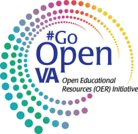
Conditional Remix & Share Permitted
CC BY-NC
When you are customizing, or remixing, you need to understand the differences between two types of resources on #GoOpenVA. One is a resource that is located on a different site; the other is a resource that has been loaded on to #GoOpenVA using Open Author. This 1:45 minute video explains the two types.
- Subject:
- Professional Learning
- Material Type:
- Visual Media
- Author:
- #GoOpenVA Administrator
- Date Added:
- 05/06/2020